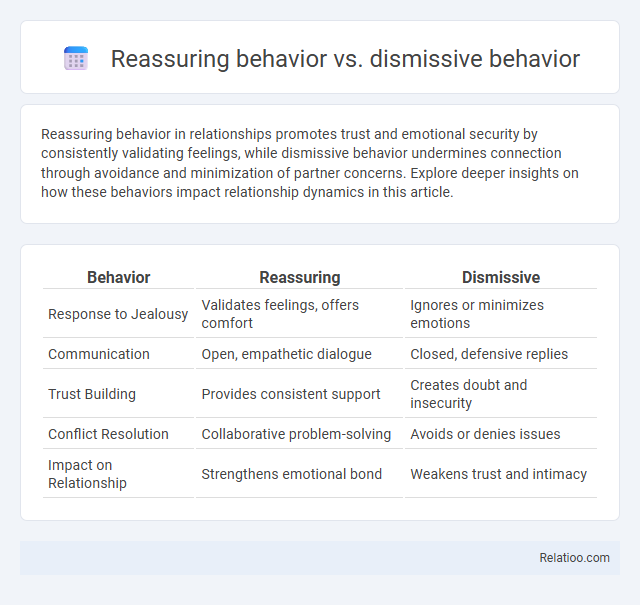Reassuring behavior in relationships promotes trust and emotional security by consistently validating feelings, while dismissive behavior undermines connection through avoidance and minimization of partner concerns. Explore deeper insights on how these behaviors impact relationship dynamics in this article.
Table of Comparison
| Behavior | Reassuring | Dismissive |
|---|---|---|
| Response to Jealousy | Validates feelings, offers comfort | Ignores or minimizes emotions |
| Communication | Open, empathetic dialogue | Closed, defensive replies |
| Trust Building | Provides consistent support | Creates doubt and insecurity |
| Conflict Resolution | Collaborative problem-solving | Avoids or denies issues |
| Impact on Relationship | Strengthens emotional bond | Weakens trust and intimacy |
Understanding Reassuring vs Dismissive Behavior
Understanding reassuring versus dismissive behavior is essential for fostering healthy communication and emotional support. Reassuring behavior validates feelings, offers comfort, and strengthens trust, while dismissive behavior minimizes or ignores emotions, leading to feelings of isolation and misunderstanding. Recognizing these patterns helps you respond empathetically and build stronger interpersonal relationships.
Key Characteristics of Reassuring Behavior
Reassuring behavior is characterized by empathy, consistent support, and active listening, fostering trust and emotional safety in relationships. This behavior contrasts with dismissive behavior, which involves minimizing others' feelings and avoiding emotional engagement, often leading to distance and misunderstanding. Key characteristics of reassuring behavior include validating emotions, offering comfort, and encouraging open communication to promote psychological well-being.
Common Traits of Dismissive Behavior
Dismissive behavior is characterized by minimizing others' feelings, avoiding emotional intimacy, and prioritizing independence over connection. Individuals displaying dismissive traits often downplay the importance of relationships and react with detachment or indifference during conflicts. This contrasts with reassuring behavior, which promotes empathy, support, and validation in interactions.
Psychological Impact on Recipients
Reassuring behavior fosters emotional security, reduces anxiety, and promotes trust by validating the recipient's feelings, leading to increased psychological well-being and resilience. Dismissive behavior, characterized by ignoring or minimizing emotions, often results in feelings of invalidation, decreased self-esteem, and heightened stress or emotional distress. In contrast, consistent reassuring responses enhance attachment security and support mental health, while dismissive responses can contribute to emotional withdrawal and psychological vulnerability.
Communication Styles: Supportive vs Dismissive
Reassuring behavior in communication emphasizes empathy, active listening, and validation, fostering trust and emotional security in relationships. Dismissive behavior minimizes or ignores others' feelings and perspectives, leading to misunderstandings and emotional distance. Supportive communication styles enhance collaboration and conflict resolution, while dismissive styles contribute to disengagement and relational strain.
Emotional Outcomes of Each Approach
Reassuring behavior promotes emotional security by validating feelings and fostering trust, which reduces anxiety and enhances emotional resilience. Dismissive behavior often leads to feelings of neglect and emotional withdrawal, increasing stress and damaging interpersonal relationships. Consistent reassuring responses cultivate a positive emotional climate, improving overall mental well-being and relational satisfaction.
Situational Examples: Reassuring vs Dismissive
Reassuring behavior involves validating your feelings and providing comfort, such as when a friend listens attentively and offers supportive words during a stressful situation. Dismissive behavior occurs when concerns are minimized or ignored, for instance, when someone responds to your worries with indifference or deflects the conversation away from your emotional experience. Recognizing these situational examples helps you navigate relationships by identifying when your emotional needs are acknowledged or overlooked.
Long-term Effects on Relationships
Reassuring behavior fosters trust and emotional security in relationships, promoting long-term intimacy and resilience. In contrast, dismissive behavior can lead to emotional distancing, eroding trust and increasing the risk of relationship dissatisfaction over time. Consistently displaying reassuring behavior supports healthy communication patterns, which are critical for sustaining lasting and fulfilling connections.
How to Shift from Dismissive to Reassuring Behavior
Shifting from dismissive to reassuring behavior requires consistent self-awareness and active communication techniques such as validating others' emotions and demonstrating empathy. You can foster trust and emotional safety by listening attentively, acknowledging concerns without judgment, and offering supportive feedback. Practicing patience and mindfulness helps replace defensiveness with understanding, facilitating healthier, more secure relationships.
Building a Supportive Communication Culture
Reassuring behavior fosters trust and openness by validating emotions and encouraging honest dialogue, essential for building a supportive communication culture. In contrast, dismissive behavior undermines connection by ignoring feelings and minimizing concerns, which can erode psychological safety and teamwork. Prioritizing consistent reassurance strengthens interpersonal relationships and cultivates an environment where individuals feel valued and heard.

Infographic: Reassuring behavior vs Dismissive behavior
 relatioo.com
relatioo.com